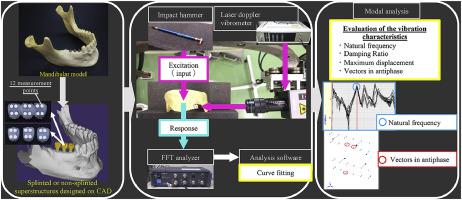Journal of the Mechanical Behavior of Biomedical Materials ( IF 3.3 ) Pub Date : 2020-09-01 , DOI: 10.1016/j.jmbbm.2020.104050 Takahiro Sasaki 1 , Hidemi Nakata 1 , Akihiro Suzuki 1 , Tamaki Hada 2 , Shohei Kasugai 1 , Shinji Kuroda 1

|
This study evaluated the effects of two types of superstructures (splinted crown and non-splinted crown) on four vibration characteristics (natural frequency, damping ratio (DAR), vectors in antiphase, maximum displacement (MDP)) by using modal analysis. These structures were fabricated on three implants placed in the mandibular free-end defect model. After placing three implants on a mandibular distal extension model with missing teeth, the three-unit splinted and non-splinted crowns were designed on the CAD software. Subsequently, the zirconia disc was milled using a milling machine to produce the superstructures (n = 5). After establishing four measurement points on each crown of the prostheses, a vibration was applied to the mandible model with an impact hammer, and the transfer function of each measurement point was identified. Using the modal analysis software, the natural frequency and damping ratios were calculated from the transfer function, modal shapes at each natural frequency were observed, and maximum displacement that takes into account the lateral force during mastication was simulated. The t-test was performed for each of the averaged values of natural frequency, maximum displacement, and damping ratio (p < 0.05). Mann-Whitney U test was performed on the average of the number of vectors in antiphase (p < 0.05). The mean natural frequency was significantly higher in the splinted crown (758.2 ± 2.8 Hz) than that in the non-splinted crown (752.8 ± 3.7 Hz) (P = 0.047). The mean damping ratio was not significantly different for the splinted (3.3 ± 0.2%) and non-splinted crowns (3.2 ± 0.3%) (P = 0.535). The average number of vectors in antiphase was significantly smaller in the non-splinted crown (4.4 ± 0.9) than in the splinted crown (10 ± 2.5) (P = 0.008). The mean value of the maximum displacement was significantly smaller in the splinted crown (6.7 ± 1.1 μm) than that in the non-splinted crown (7.3 ± 0.6 μm) (P = 0.048). Within the limitations of this study, the vibration characteristics of the superstructures differed between designs with splinted and non-splinted crowns. Crown splinting increased the rigidity and natural frequency and decreased the MDP. However, the higher number of vectors in antiphase indicated more twists in the superstructures during vibration. The non-splinted crowns showed a lower natural frequency and a greater maximum displacement; however, they comprised fewer vectors in antiphase, indicating that the twist during vibration was less than that observed with the splinted crowns. Thus, our results suggest that crown splinting reduces the deformation of the superstructure, implants, and the surrounding tissues in comparison to the deformation observed when no splinting is performed.
中文翻译:

使用模态分析比较放置在缺少牙齿的下颌远端延伸模型中的三种植入物的夹板和非夹板上部结构。
本研究通过模态分析评估了两种类型的上部结构(夹冠和非夹冠)对四个振动特性(固有频率,阻尼比(DAR),反相矢量,最大位移(MDP))的影响。这些结构是在放置在下颌自由端缺损模型中的三个植入物上制造的。将三个植入物放置在缺少牙齿的下颌远侧延伸模型上后,在CAD软件上设计了三个单位的夹板和非夹板牙冠。随后,使用铣床对氧化锆圆盘进行铣削,以生产上部结构(n = 5)。在假体的每个冠部上建立四个测量点后,用冲击锤对下颌模型施加振动,并确定每个测量点的传递函数。使用模态分析软件,通过传递函数计算固有频率和阻尼比,观察每个固有频率下的模态形状,并模拟了在咀嚼过程中考虑了侧向力的最大位移。的对固有频率,最大位移和阻尼比的平均值进行t检验(p <0.05)。曼-惠特尼ü对反相的载体数量的平均值进行了检验(p <0.05)。夹板牙冠的平均固有频率(758.2±2.8 Hz)明显高于未夹板牙冠的平均固有频率(752.8±3.7 Hz)(P = 0.047)。夹板(3.3±0.2%)和非夹板胎冠(3.2±0.3%)的平均阻尼比无显着差异(P = 0.535)。非夹冠的反相向量平均数(4.4±0.9)明显小于夹冠的(10±2.5)(P = 0.008)。夹板牙冠的最大位移平均值(6.7±1.1μm)显着小于未夹板牙冠的最大位移平均值(7.3±0.6μm)(P = 0.048)。在这项研究的范围内,上部结构的振动特性在带夹板和非夹板胎冠的设计之间有所不同。牙冠夹板增加了刚度和固有频率,并降低了MDP。但是,反相中向量的数量越多,表明在振动过程中上部结构的扭曲越多。无夹板的表冠显示出较低的固有频率和较大的最大位移。但是,它们包含的反相矢量较少,这表明振动期间的扭曲小于夹板式表冠观察到的扭曲。因此,我们的结果表明,与不进行夹板操作时观察到的变形相比,牙冠夹板减少了上部结构,植入物和周围组织的变形。反相向量的数量越多,表明在振动过程中上部结构的扭曲越多。无夹板的表冠显示出较低的固有频率和较大的最大位移。但是,它们包含的反相矢量较少,这表明振动期间的扭曲小于夹板式表冠观察到的扭曲。因此,我们的结果表明,与不进行夹板操作时观察到的变形相比,牙冠夹板减少了上部结构,植入物和周围组织的变形。反相向量的数量越多,表明在振动过程中上部结构的扭曲越多。无夹板的表冠显示出较低的固有频率和较大的最大位移。但是,它们包含的反相矢量较少,这表明振动期间的扭曲小于夹板式表冠观察到的扭曲。因此,我们的结果表明,与不进行夹板操作时观察到的变形相比,牙冠夹板减少了上部结构,植入物和周围组织的变形。表示振动期间的扭曲小于夹板式表冠的扭曲。因此,我们的结果表明,与不进行夹板操作时观察到的变形相比,牙冠夹板减少了上部结构,植入物和周围组织的变形。表示振动期间的扭曲小于夹板式表冠的扭曲。因此,我们的结果表明,与不进行夹板操作时观察到的变形相比,牙冠夹板减少了上部结构,植入物和周围组织的变形。











































 京公网安备 11010802027423号
京公网安备 11010802027423号